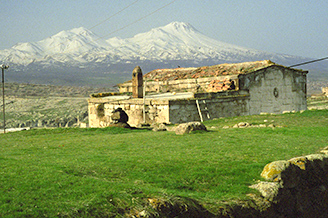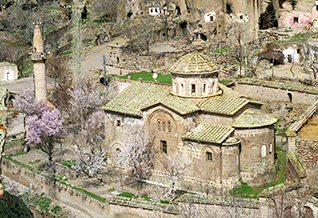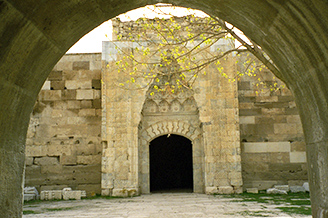Western Turkey
Day 10 - Friday, 10 April 1998
It was Good Friday, and we were in a town where one of the very earliest monasteries was established. Unfortunately, largely due to fighting a sinus infection, I felt too tired to take in the expected walk, so after breakfast I went back to bed while Jim saw the monastery and the church. He took such awesome pictures, that when I saw them, I wished I'd forced myself to go. But sensory overload was a daily, perhaps several times a day experience here in Turkey. There was little time to process and meditate on what we had seen and heard. After the breakfast lectures, I really needed some time.

But breakfast was first, and we met in a local home for the meal. It is actually a pension, but has no outward sign of being so. Julie and Raquella had spent the night here, and were up early so that the sleeping room could be reconverted into a living room - or in this case a breakfast room. We sat on the floor eating at low tables, and drank tea made in wonderful double-decker teapots. The strong tea was in one pot and hot water in the other. Little tulip glasses were half-filled with tea, then the water added. I'd really love to have one of those pots, but they are bulky, and "we'd have to carry it." (Next trip, I want to bring along a luggage servant.)
After breakfast, Meli gave us a lecture and demonstration on the various ways and reasons that scarves are worn in this part of the world, and how to wrap them. Her second lecture was on Islam.
Tom Fritch did a good job of taking notes and wrote the following in the community journal:
Scarves started as sun protection. People of different areas tie the scarves in different ways identifying who they are. The cotton scarves of Turkey all are dyed in one location. Northern Turkey uses two scarves (with an outer silk scarf) for rain protection. Eastern Turkey women tend to tie the scarves on the side of their head and wrap the scarf around their neck for cold protection. People from the Taurus area wear a fez type hat and with a scarf tied around it. City people tie the scarves in a simple way under their necks. Fundamentalists "close in" themselves with the scarf and often place the scarf in their mouth.
The Islam talk was enlightening to us all. "Religions are to make people happy." Islam is no exception. The focus of Islam is human beings. Humans are models of perfection.
5 Principles (pillars) of Islam
- There is one god - Allah. If you believe in Allah, you are a Moslem. There are not initiation rites to Islam like Baptism in Christian Faith.
- Prayer. Ideally a Moslem prays 5 times a day. Meli then showed us how physical this prayer is and how intentionally it is meant to keep the body healthy as well as the mind. (From the editors notebook: The standing, bowing, kneeling routine, praying in different directions, is basically an exercise routine, designed to help the body maintain flexibility. The prayers are fixed prayers, perhaps a mental exercise.)
- Fasting. For one month during Ramadan a Moslem does not eat from sunrise to sunset. This is done to show commitment plus to purge the body. No alcohol or even the use of such things as lemon essence is permitted. Worldwide application of this shows a sense of oneness. "All are equal like the teeth of a comb." [Allah]
- Charity. Being good yourself is not enough. There is an obligation to pay 1/40th of your earnings (excluding debt). You must personally give your gift. You can't just write a check.
- Once in a lifetime you should make a trip to Mecca. Mohammed said "Don't tell me how much money you have, tell me how much have traveled." The idea is to open eyes to outside ideas and other worlds.
Meli then briefly touched on the many types of Islam. She describes these as streams or routes to a central ocean. All are different but end at the same place. Areas of the world often determine the brand of Islam. An example given was Semitic tradition (Arabian) was to kill girl babies before Mohammed. He thought this was wrong. He recommended polygamy where a man can have 4 wives. Shamanistic tradition (in Turkey) believed everything and everyone was equal. There is no history of polygamy in Turkey since women were never less than equal.
Islam embraces 128,000 prophets but 28 are specifically named. Jesus was one of these. Islam accepts all of Christianity except the Nicene Creed, which states that Jesus, is God.
The Imam is a social servant as well as a religious leader.
My thoughts are that Islam cannot possibly accept all of Christianity up to the Nicene Creed without accepting Jesus as Christ, the Son of God. Here is our basic difficulty. To the Muslim, Jesus is just a prophet. A highly respected prophet, but not God. But on this trip, I am beginning to realize that many, perhaps most, of the people who were called Christians in this part of the world had themselves drifted very far away from the Christ of the Bible by Mohammed's time. It is small wonder that Mohammed and his followers are confused about the identity of Christ.
The paintings on the church walls deify Mary, and assign the works of Christ to her. The paintings of Jesus in the churches are mostly just as a little baby, or as a pathetically crucified human. The council of Nicea was convened because of this controversy, that people did not know how to understand Jesus as being both fully human and fully divine. Even the Nicene Creed did not resolve the issue, and the previously mentioned Cappadocian Fathers were hard-put to keep the truth alive. It is a mocking attack that still throws stones and nips at the heels of true Christianity.

While I rested, Jim and the others hiked on the mountainside. They visited a monastery and an old church. One legend says that the music of the Monastic or Gregorian Chants originated here. Jim's pictures and video reveal more rock carved homes, another underground city, and more of the breathtaking beauty of Cappadocia. In a very old church (St. Gregory's), the group sang Kumbaya, This is the Day, and Amazing Grace.
After lunch at Hotel Karvalla, we drove on toward Konya. Meli pointed out the poplar trees growing alongside the streams, and told us of their significance to the people. When a baby is born, a poplar tree is planted. It is his or her investment for the future. After it has grown for a while, the top can be cut for firewood, and the tree soon regrows and can be used again and again. When needed, the trunk can be cut down to make a house. Ataturk began a reforestation program in Turkey, and each one of the trees we see represents the growth of the new babies and the new nation.
Caravanserai at Sultanhani
We stopped to explore the Caravanserai at Sultanhani. The size and structure is impressive, as we try to picture the dozens to hundreds of animals that would have needed food and shelter, as well as the humans. Men, women and children would have been in the groups. As different caravans met here, socialization between groups would have been the catalyst for sharing music, stories, recipes and cultures.

Caravans date back to earliest Anatolia, following roads initially used for trade or military purposes. The so-called Silk Road began in Eastern Asia, and spread out in Turkey, taking the treasures of the East to the eager people of the west. At the western edges of Anatolia, the caravans came up against the sea. And still, the people who controlled the Bosphorus controlled the trade route. I am reminded that Columbus' voyage across the sea to America was allegedly an attempt to find another way to get at the coveted eastern spices.
On the bus again, someone asked Meli about the legal structure in Turkey, and she told us about Suleyman, the lawmaker from 1520. Today's law structure is built on German trade law, Roman criminal law, and Swiss civil law.
After answering all the easy questions, at last Meli agreed to deal with a question some wanted to have answered, and others hoped would not be brought up. It seemed a heavy and difficult issue for Meli, and her face was sad as she began to talk about the Armenian massacre. "To understand what happened," she said, "you must understand the history." And once again, the yellowed sheets of history fluttered in the wind, back to days when the Ottoman Empire conquered Istanbul. Diversity was encouraged in the empire and included the following:
- Armenians, an ethnic group who followed Gregory the Illuminator.
- Muslims, whose young men spent seven years in the military supported by taxes paid by the other groups.
- Syrian orthodox
- Greek orthodox
- Catholic Europeans who built missions and schools
A nation, said Meli, is one because it has ethnic and religious identity. The Armenians were originally one nation. Some became converted to Roman Catholicism while others remained orthodox. To further complicate the situation, American Protestant missionaries came to Eastern Anatolia and to Iran, and many Armenians joined them. Armenians as a nation no longer had unity, but began to be divided against each other.
In the early 1900s, the West first used Armenians as a buffer against communism. Then Catholic Armenians were turned against the Turks. "It is a major British tool," Meli said, "to divide and rule." (I hear an echo in my brain, "Divide and conquer!" as a rallying war cry.)
The Protestants saw the danger coming, and Protestant Armenians were rescued and taken to America. The Catholic Armenians were left, and they are the ones who suffered the Turkish wrath. "It is a very sad story," Meli repeated. "But to understand it, you must look at the history."
The ringing of Meli's mobile phone shattered the somber mood in the bus. The pages of history fall again in the dust beside the road. We are entering Konya, and the hotel is calling her to synchronize arrival time. They want to reserve space in front of the hotel for Metin to park the bus. Meli's network of contacts seems to us to run very smoothly, and people are eager to make our trip a good one.
Meli pointed out the church of St. Paul, and said that Konya is the town called Iconia in the Bible. Paul was here, but it seems that all that is left of his impact on this town is the small museum church that bears his name. Jim and I tried to visit it on Saturday morning, but found it locked up tight.
Otel Sifa welcomed us, and dinner across the street again demonstrated the smoothly running Meli tour, as salads awaited us on arrival. Food kept coming, course after course, and we were too stuffed for dessert. Not quite, we decided to share. There's always room for dessert!